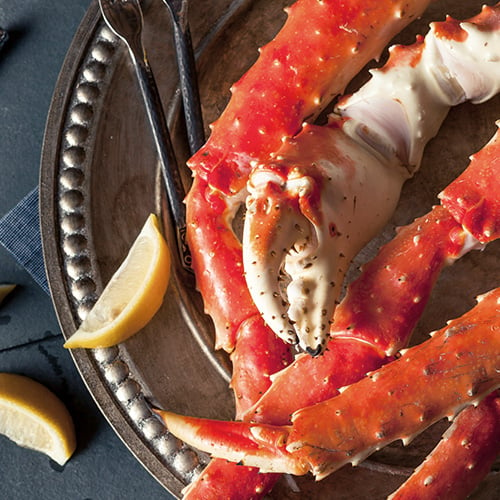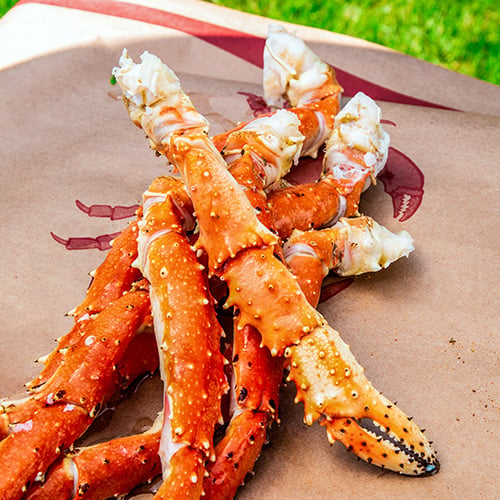King crab legs are easy to prepare and can be a profitable addition to your menu. We’ll let you in on a little secret - most king crab legs are already cooked! When you cook them, you’re just reheating them. The trick is to avoid over-cooking king crab to preserve the tenderness and flavor. Keep reading to learn the best ways to cook Alaskan king crab.
Shop Alaskan King CrabWhat Is King Crab?
King crabs are a large species of crab harvested from the waters surrounding Alaska and the Aleutian Islands. Because of its great size and the limited fishing season, king crab is more expensive than other types of crabs. It also has a milder taste that's often compared to lobster. King crab is a delicacy and makes an enticing seafood special, especially during the summer months.
Learn How to Cook King Crab
Watch our video to learn three different way to prepare king crab legs:
Cooking King Crab
King crab is cooked and frozen immediately after harvesting. This preserves the crab meat and makes it safe to ship king crabs all over the world. That's why you don’t need to operate in a coastal town to add Alaskan king crab legs to the menu! Unlike picking a blue hard-shell crab, eating king crab is much less work which makes it an appealing seafood option for customers.
The night before you plan to prepare the king crab, place the frozen crab legs in your walk-in cooler to thaw. This is the easiest way to thaw the crab meat before cooking. Rinse the thawed crab legs with water to remove any sand, and now you're ready to cook! Check out these three popular cooking methods:
1. Steaming

Steaming is a quick, easy way to prepare king crab. To get started, you'll need a large stock pot and a steamer basket. Try a steamer kit if you're cooking outdoors or hosting a seafood boil.
How to Steam King Crab Legs
- Fill pot with water until just below steamer basket or steaming grate.
- Heat water to a boil (on range top or outdoor burner).
- Add desired seasonings to water.
- Carefully place thawed crab legs into steamer basket and reduce heat.
- Allow to simmer for 5 to 7 minutes.
- Remove crab legs with high-heat tongs and rinse before plating.
- Serve with melted butter and lemon wedges.
How Long to Steam King Crab Legs?
King crab legs cook quickly, so you only need to steam them for roughly 5-7 minutes if they are already thawed.
2. Grilling

If you haven't tried grilling fish and seafood yet, it's a great way to get more versatility out of your outdoor grilling equipment. Freshly grilled king crab legs make an enticing summer special. The grill marks provide visual appeal, and you won't need to clean the steamer pot afterward. All you need is an outdoor grill and a pair of high-heat tongs.
How to Grill King Crab Legs
- Brush thawed crab legs with olive oil.
- Heat grill or charbroiler to 300 degrees Fahrenheit.
- Place king crab legs directly onto grill grate.
- Cook for 5-7 minutes, then flip the legs and cook an additional 5-7 minutes.
- Serve with melted butter and lemon wedges.
How Long to Grill King Crab Legs?
King crab legs only take about 10 to 15 minutes to cook on the grill. Just make sure the grill isn't too hot or the crab legs will dry out.
3. Baking

If you don't have a steamer basket, you can get similar results by baking king crab in the oven. Cover a baking pan with aluminum foil to create a steaming effect.
How to Bake King Crab Legs
- Preheat oven to 350 degrees Fahrenheit.
- Place thawed crab legs in single layer in shallow baking pan.
- Add a small amount of water to the pan so that it covers the bottom (about 1/8" to 1/4" deep).
- Brush crab legs with butter, seasoning, and/or lemon juice.
- Cover the pan with aluminum foil and bake for 8 to 10 minutes.
- Serve with melted butter and lemon wedges.
How Long to Bake King Crab Legs?
With the oven at 350 degrees Fahrenheit, you only need to bake king crab legs for 8 to 10 minutes.
King Crab FAQ

Still have questions about cooking king crab legs? We answer some common queries below.
Is King Crab Sustainable?
Yes, king crab can be considered a sustainable seafood option depending on where it's harvested. According to Seafood Watch, king crab species that are wild-caught in Alaska are harvested in a way that causes little harm to habitats and wildlife. They recommend avoiding king crab harvested in Russia. In the US, the king crab fishing season and quotas are strictly regulated to avoid overfishing.
Is it Better to Steam or Boil King Crab?
Steaming is a gentler method of cooking than boiling. When you boil crab legs, you risk overcooking the meat which makes it rubbery. Submerging the crab legs in water when you boil also leads to water-logging of the meat. We recommend steaming for better results.
Should I Thaw King Crab Before Cooking?
While you can cook frozen king crab legs, we recommend thawing the crab overnight first. This will give you the best results because the crab legs will cook evenly and quickly.
Do You Rinse King Crab Legs Before Cooking?
It's a good practice to give your thawed king crab legs a quick rinse just in case there's any sand or dirt present on the shells.
Can You Overcook King Crab?
Yes, you can overcook king crab. Because it's already cooked and just needs to be reheated, overcooking is a common mistake. This will make the crab tough, rubbery, and not as flavorful.
Even though it's a pricey meal, king crab is easy to prepare. A simple reheat in a steamer basket is all it takes to produce delicious, flakey crab meat. If you're considering adding seafood to your menu, try Alaskan king crab for a profit-boosting nightly special.



